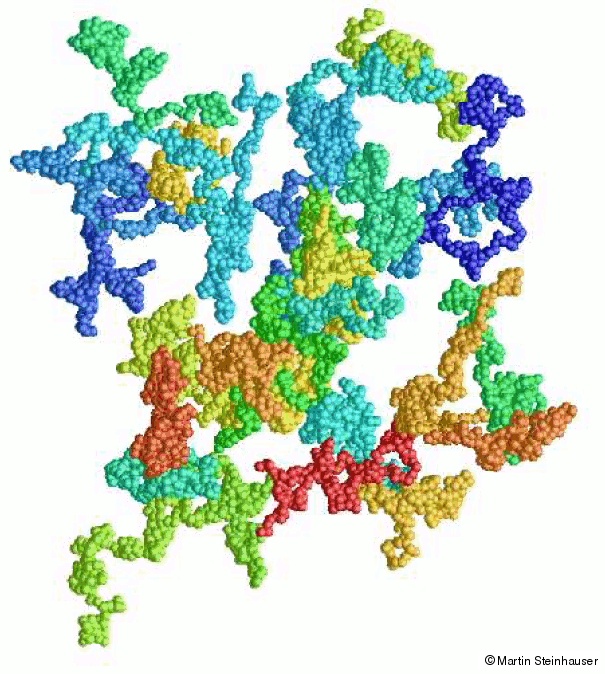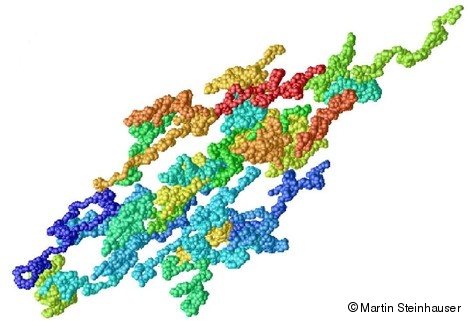The motivation for my research on polymer melts is to systematically study the dynamic scaling transition from flexible to semiflexible polymer behavior, i.e. the crossover regime, neglecting hydrodynamic interactions, and using coarse-grained molecular dynamics (MD) simulations. We focused first on the crossover from Rouse to stiff behavior of single linear chains by starting with fully flexible chains and systematically increasing the chains’ stiffness through a simulation parameter Lp (see Figure 1).
This figure shows a scaling plot of the structure function (which is the Fourier transform of the pair correlation function), exhibiting the correct limiting behavior of flexible and rod-like single linear chains. In between, we can vary the stiffness of the polymer chains smoothly in my research code MD-CUBE and thus investigate in detail the universal scaling properties of linear chains when undergoing a transition from fully flexible to stiff rod-like chain behavior. Using this method, we were able to proof that formerly published simulation results (based on atomistic simulations) on the scaling behavior of linear chains when undergoing a flexible to stiff transition were simply wrong. In the figure, d0 is the average equilibrium bond length and Lp is the persistence length of the chains, which is a way to express their stiffness.
In the simulation we can control this with a single parameter. Based on a normal mode analysis we have shown the effects of the increased chain stiffness on the scaling of the normal modes as well as on the mean square monomer displacements. For performing the simulations, we used my simulation package MD-CUBE which implements a coarse-grained bead-spring model with excluded volume interactions for the simulation of dilute solutions of polymers, respectively, for polymer melts. A simple compiler switch allows for turning on or off the interactions between different chains, i.e. the inter-chain interactions. Thus, one can easily switch the simulation from focusing on single polymers in solution to dense polymer melts. The excluded volume of each monomer is taken into account through a standard nonbonded Weeks–Chandler–Andersen (WCA) potential, which is nothing else than a cut-off Lennard-Jones type potential.
Figures 2 and 3 show snapshots of an application of my simulation code MD-CUBE to polymer melts. Figure 2 exhibits an entangled and equilibrated polymer melt with 100 linear chains of length N=200, but only 30 chains are shown for better viewing. Figure 3 displays our shear-simulations of polymer meltswith which we were able to analyze the results in terms of the mean square Rouse mode amplitudes p2. This comparison shows that in former works too small chains were investigated compared to the chain lengths in our study, and as a consequence only p-values pertaining to the crossover regime and not the bending regime (as in our studies) could be probed. Additionally, our study showed for the first time the crossing over of modes (which had been well-known theoretically) in a convincing fashion using simulation data, which had not been observed in previous numerical investigations.
Selected publications
Simulating Dynamic Crossover Behavior of Semiflexible Linear Polymers in Solution and in the Melt
M.O. Steinhauser, J. Schneider, A. Blumen
J. Chem. Phys. 2009, 130, 164902
A Molecular Dynamics Study on Universal Properties of Polymer Chains in Different Solvent Qualities. Part I. A Review of Linear Chain Properties
M.O. Steinhauser
J. Chem. Phys. 2005, 122, 094901




